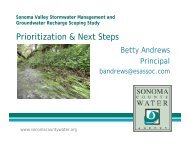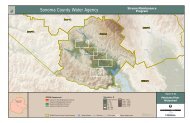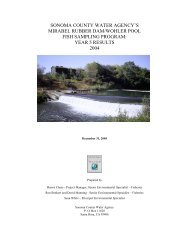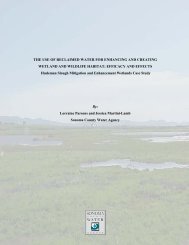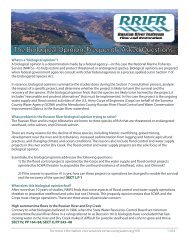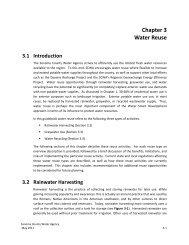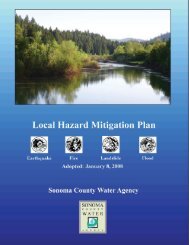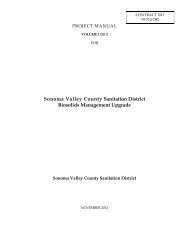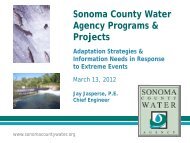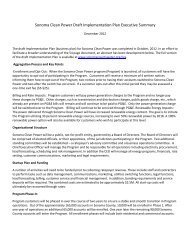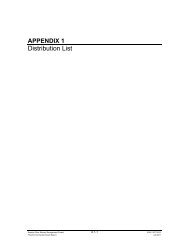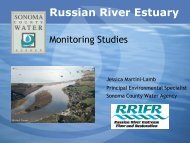Hydrography of the Russian River Estuary - Sonoma County Water ...
Hydrography of the Russian River Estuary - Sonoma County Water ...
Hydrography of the Russian River Estuary - Sonoma County Water ...
Create successful ePaper yourself
Turn your PDF publications into a flip-book with our unique Google optimized e-Paper software.
1. Introduction<br />
The <strong>Russian</strong> <strong>River</strong> Biological Opinion written by <strong>the</strong> National Marine Fisheries Service<br />
(NMFS 2008) requires <strong>the</strong> <strong>Sonoma</strong> <strong>County</strong> <strong>Water</strong> Agency (SCWA) to manage <strong>the</strong><br />
<strong>Russian</strong> <strong>River</strong> estuary in such a way as to maintain a closed mouth following natural<br />
closure during <strong>the</strong> summer management period <strong>of</strong> 15 May through 15 October. It is<br />
expected that this closed lagoon state was typical in late summer and fall prior to human<br />
perturbations <strong>of</strong> <strong>the</strong> system and that this closed lagoon state will provide improved<br />
habitat for <strong>the</strong> rearing <strong>of</strong> juvenile steelhead in <strong>the</strong> estuary (and possibly also coho).<br />
However, long-duration closures <strong>of</strong> <strong>the</strong> <strong>Russian</strong> <strong>River</strong> estuary have not been observed<br />
recently and it is unclear how stratification and water residence will play out in terms <strong>of</strong><br />
<strong>the</strong> distribution <strong>of</strong> water properties (specifically salinity, temperature, velocity, and<br />
dissolved oxygen). <strong>Water</strong> properties are key determinants <strong>of</strong> juvenile steelhead habitat,<br />
and <strong>the</strong>y are important in <strong>the</strong>ir relation to water quality conditions conducive to<br />
ecosystem health and human “beneficial uses”.<br />
Bodega Marine Laboratory (BML) at <strong>the</strong> University <strong>of</strong> California Davis was contracted by<br />
<strong>the</strong> SCWA to conduct a study <strong>of</strong> <strong>the</strong> estuary that provides a view <strong>of</strong> circulation,<br />
stratification, salinity, and residence during <strong>the</strong> summer and fall <strong>of</strong> 2009. The aim was to<br />
provide SCWA with a basis for designing a more complete hydrological analysis by<br />
identifying phenomena and processes that are critical to future management <strong>of</strong> <strong>the</strong><br />
estuary and <strong>the</strong> multiple human and ecosystem uses <strong>of</strong> this environment. Data were<br />
collected as a basis for (i) assessment <strong>of</strong> <strong>the</strong> hydrological condition <strong>of</strong> <strong>the</strong> estuary during<br />
<strong>the</strong> 2009 dry season, (ii) future analyses that will provide understanding <strong>of</strong> how river<br />
flow and mouth state control estuary hydrology and through that water-column habitat in<br />
<strong>the</strong> estuary, and (iii) validation and inputs for future numerical modeling <strong>of</strong> <strong>the</strong> estuary.<br />
The <strong>Russian</strong> <strong>River</strong> estuary is a bar-built, drowned-river-valley estuary. Although this<br />
type <strong>of</strong> estuary is common – indeed typical – in central and nor<strong>the</strong>rn California, <strong>the</strong><br />
characteristic hydrological patterns and underlying hydrodynamic processes are not well<br />
documented nor understood. In this study, it was necessary to obtain primary field data<br />
and to conduct data analyses in order to obtain a preliminary understanding <strong>of</strong> this<br />
system and thus to allow discussion <strong>of</strong> possible future conditions.<br />
This report is a summary <strong>of</strong> results from <strong>the</strong> field program in <strong>the</strong> <strong>Russian</strong> <strong>River</strong> estuary<br />
during <strong>the</strong> summer and fall <strong>of</strong> 2009, during which river flows were lower than normal.<br />
This report is preceded by a data report (Behrens & Largier 2010), in which all field data<br />
are described and graphically presented.<br />
7




